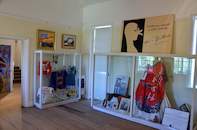Walter Battiss Art Museum
The historic town of Somerset East is situated along the local Blue Crane Tourism Route, traversing the edge of the arid Karoo region. An interesting mix of Victorian, Georgian and vernacular architecture, local coffee shops, a ‘proper’ pub, floral country gardens and the intriguing Walter Battiss Museum make for an enchanting wander along the village streets.

Willem Prinsloo was the first recorded settler in the early 1770s, but it was only in 1814 that Lord Charles Somerset chose the location for Somerset Farm to grow crops for British troops serving on the frontier.
After the war, in 1825 a township was laid out and named after Lord Somerset, the "East" was to distinguish it from the other Somerset "West" near Cape Town. Many gracious heritage buildings still line on Paulet Street, the first street of this new township.
Also of interest is the Somerset East Museum, with its splendid rose garden and oak trees. Built in 1818, the stately house served as a residence, a drostdy (magistrate's court) and as a parsonage. The museum, furnished in the style of a late-19th-century clergyman's home, depicts the history of the town and surrounding district as far back as 1770.
The Walter Battiss Art Museum is dedicated to Prof. Walter Battiss bequeathed a collection of his work to the people of Somerset East. This was the largest Battiss collection in South Africa before the Jack Ginsberg collection was given to Wits Art Museum 2016. The Museum was fully restored when serious deterioration of the building was identified in 1999, and it reopened in 2004.